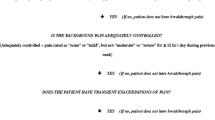Abstract
Context
Breakthrough cancer pain is associated with a high burden of physical, psychological and social problems in quantitative studies. Individual experiences of living with breakthrough pain have not been studied.
Objectives
This study aims to explore the individual experience of living with breakthrough cancer pain using a qualitative methodology.
Methods
In depth semi-structured interviews were conducted in ten patients with breakthrough cancer pain, and a qualitative content analysis was performed.
Results
The overarching themes that emerged were daily living, communication with health care professionals and management of breakthrough pain.
Conclusions
Recognising the impact of breakthrough pain and the issues expressed by patients regarding communication and medication gives the clinician a framework for assessment and intervention.
Similar content being viewed by others
References
Davies A, Dickman A, Reid C, Stevens A, Zeppetella G (2009) The management of cancer-related breakthrough pain: recommendations of a task group of the Science Committee of the Association for Palliative Medicine of Great Britain and Ireland. Eur J Pain 13:331–338
Mercadante S, Radbruch L, Caraceni A, Cherny N, Kaasa S, Nauck F et al (2002) Episodic (breakthrough) pain: consensus conference of an expert working group of the European Association for Palliative Care. Cancer 94(3):832–839
Portenoy RK, Payne D, Jacobsen P (1999) Breakthrough pain: characteristics and impact in patients with cancer pain. Pain 81:129–134
Hwang SS, Chang VT, Kasimis B (2003) Cancer breakthrough pain characteristics and responses to treatment at a VA medical center. Pain 101:55–64
Skinner C, Thompson E, Davies A (2006) Clinical features. In: Davies A (ed) Cancer-related breakthrough pain. Oxford University, Oxford, pp 13–22
Portenoy RK (1997) Treatment of temporal variations in chronic cancer pain. Semin Oncol 24:S16-7–S16-12
Davies AN, Vriens J, Kennett A, McTaggart M (2008) An observational study of oncology patients’ utilization of breakthrough pain medication. J Pain Symptom Manage 35(4):406–411
Elos S, Kyngas H (2008) The qualitative content analysis process. J Adv Nurs 62:107–115
Attride-Stirling J (2001) Thematic networks: an analytical tool for qualitative research. Qual Res 1:385
Mercadante S, Arcuri E (1998) Breakthrough pain in cancer patients: pathophysiology and treatment. Cancer Treat Rev 24:425–432
Laverty D, Davies A (2006) Assessment. In: Davies A (ed) Cancer-related breakthrough pain. Oxford University, Oxford, pp 23–30
Oldenmenger W, Sillevis Smitt P, Van Dooren S, Stoter G, Van Der Rijt C (2009) A systematic review on barriers hindering adequate cancer pain management and interventions to reduce them: a critical appraisal. Eur J Cancer 45:1370–1380
Acknowledgements
This study was funded by the Royal Marsden Hospital Department of Palliative Medicine Research Fund and a United Kingdom Association of Palliative Medicine research bursary. We would like to thank Natalie Pattison for her valuable support.
Conflict of interest
The research sponsor is Imperial College, London that employs the authors Katherine Webber and Martin Cowie. The authors have full control of the primary data and agree to allow the journal to review this data if necessary.
Author information
Authors and Affiliations
Corresponding author
Rights and permissions
About this article
Cite this article
Webber, K., Davies, A.N. & Cowie, M.R. Breakthrough pain: a qualitative study involving patients with advanced cancer. Support Care Cancer 19, 2041–2046 (2011). https://doi.org/10.1007/s00520-010-1062-z
Received:
Accepted:
Published:
Issue Date:
DOI: https://doi.org/10.1007/s00520-010-1062-z




